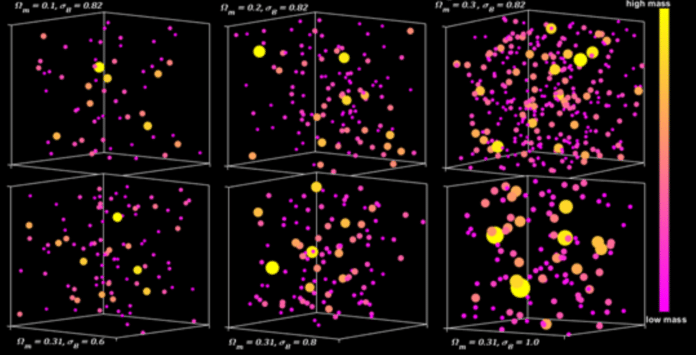Scientists believe the universe comprises three things: normal matter, dark matter, and dark energy. Ordinary matter is the atoms that make up all cosmic objects in the universe, yet it accounts for the smallest proportion of the cosmos. Due to the mysterious and dark nature of dark energy and matter, it is hard to determine exactly how much of the universe they account for. But what about the matter?
How much matter exists in the universe?
An international team, including scientists at Chiba University, used a well-proven technique to calculate the amount of normal matter in the universe: they compared the observed number and mass of galaxy clusters per unit volume with predictions from numerical simulations.
In a new study, scientists successfully measured the total amount of matter for the second time. They found that matter makes up 31% of the universe’s total amount of matter and energy, with the remainder consisting of dark energy.
Measuring the amount of matter in the universe can help understand how the universe evolved — and what the rest of it is composed of.
Co-author Gillian Wilson, Abdullah’s graduate advisor and Professor of Physics and Vice Chancellor for research, innovation, and economic development at UC Merced. “The number of clusters observed at present, the so-called’ cluster abundance,’ is susceptible to cosmological conditions and, in particular, the total amount of matter.”
Anatoly Klypin from the University of Virginia said, “A higher percentage of the total matter in the universe would result in more clusters being formed. But it is difficult to accurately measure the mass of any galaxy cluster as most of the matter is dark, and we cannot see it directly with telescopes.”
Scientists used an indirect tracer of cluster mass to overcome this difficulty. That fact is more massive clusters contain more galaxies than less massive clusters (mass richness relation: MRR). The cluster mass–richness relation (MRR) is an observationally efficient and potentially powerful cosmological tool for constraining the matter density and the amplitude of fluctuations using the cluster abundance technique.
Since galaxies are made up of bright stars, counting the number of galaxies in a cluster can be used to infer its overall mass. The scientists determined the total mass of each cluster by counting the galaxies in each one of the clusters in their sample from the Sloan Digital Sky Survey.
The number and mass of galaxy clusters found per unit volume were then compared to forecasts from computer models. The amount of matter in the universe that provided the best fit between observations and simulations was 31%, which was in perfect accord with the results of Planck satellite studies of the cosmic microwave background (CMB).
Tomoaki Ishiyama from Chiba University said, “We have succeeded in making the first measurement of matter density using the MRR, which is in excellent agreement with that obtained by the Planck team using the CMB method. This work further demonstrates that cluster abundance is a competitive technique for constraining cosmological parameters complementary to noncluster techniques such as CMB anisotropies, baryon acoustic oscillations, Type Ia Supernovae, or gravitational lensing.”
The study demonstrates that the MRR technique is a powerful tool for determining cosmological parameters. It also explains how it can be applied to new datasets that are available from large, wide, and deep-field imaging and spectroscopic galaxy surveys such as those performed with the Subaru Telescope, Dark Energy Survey, Dark Energy Spectroscopic Instrument, Euclid Telescope, eROSITA Telescope, and the James Webb Space Telescope.
Journal Reference:
- Mohamed H. Abdullah, Gillian Wilson, Anatoly Klypin, Tomoaki Ishiyama. Constraining Cosmological Parameters using the Cluster Mass-Richness Relation. The Astrophysical Journal. DOI: 10.3847/1538-4357/ace773
